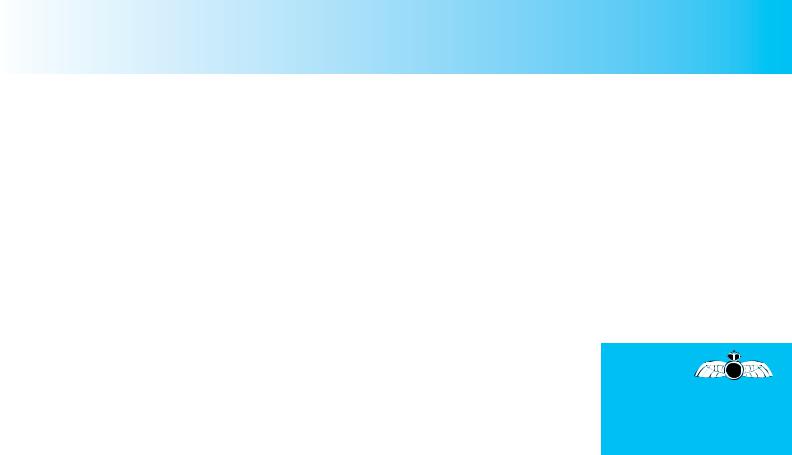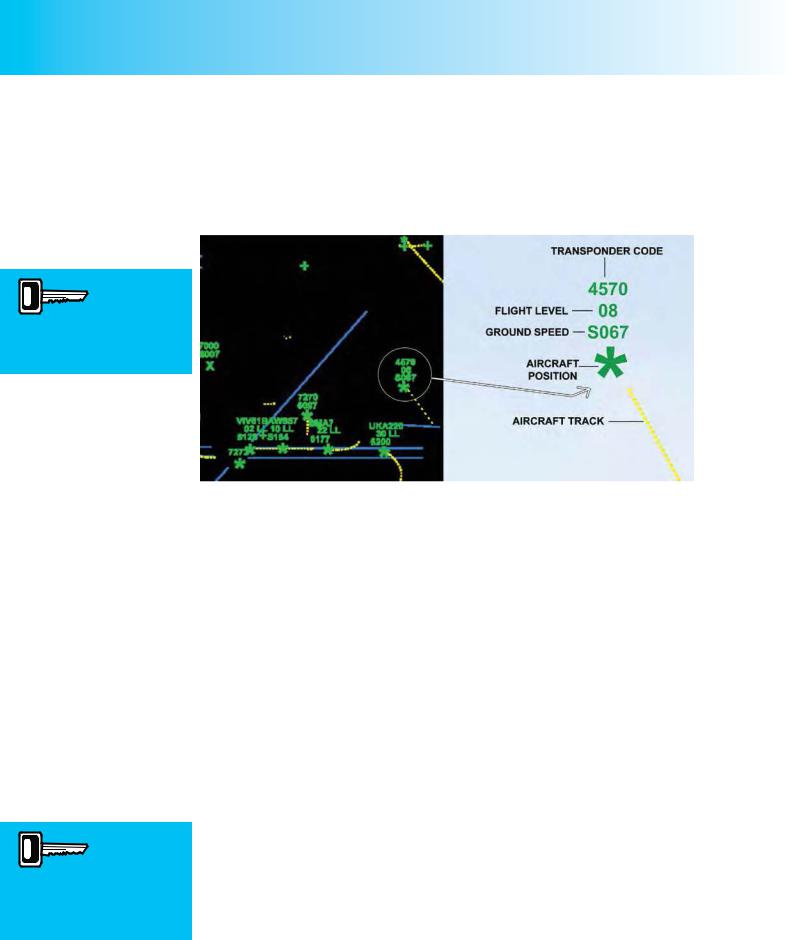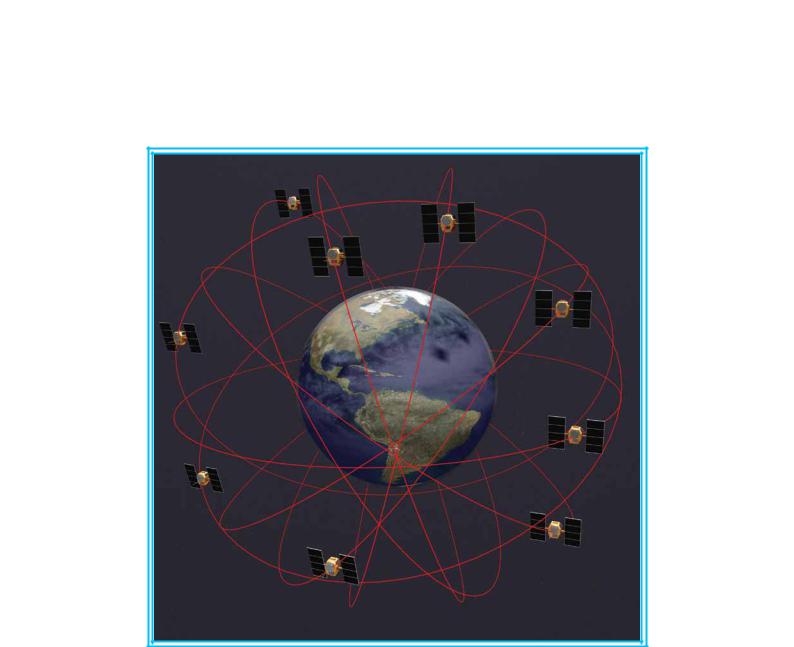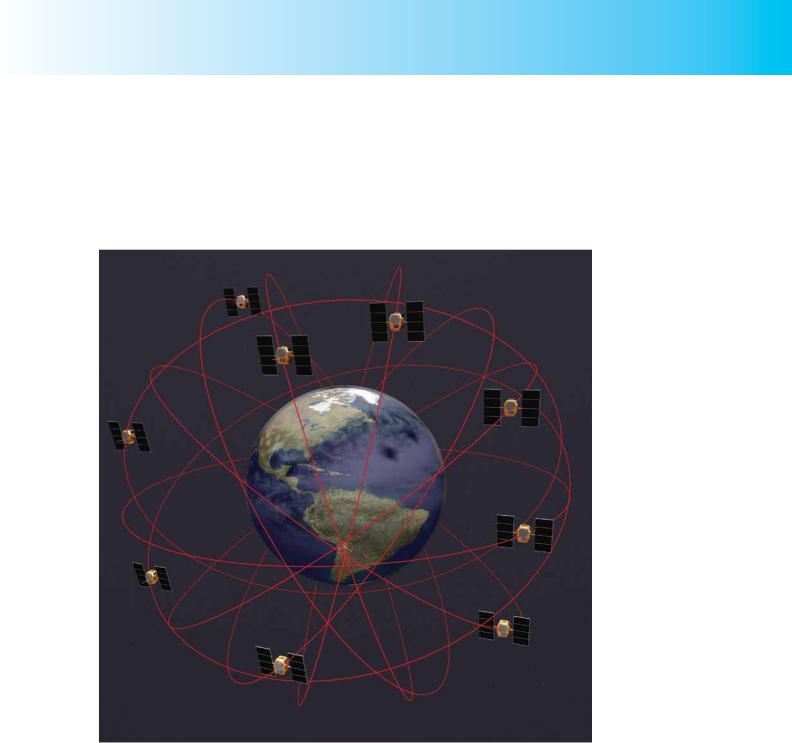
ppl_03_e2
.pdf
ID: 3658
Customer: Oleg Ostapenko E-mail: ostapenko2002@yahoo.com
Customer: Oleg Ostapenko E-mail: ostapenko2002@yahoo.com
CHAPTER 20: SECONDARY SURVEILLANCE RADAR
With the selector moved to the TEST position, the pilot can check whether the transponder is operating correctly. If the transponder is serviceable and functioning as it should, the transponder generates a self-interrogating signal and the REPLYIDENT light illuminates.
The IDENT button is activated by the pilot only on the request of air traffic control.
When the pilot presses the IDENT button, a pulse is generated by the transponder which causes a particular display to appear, for several seconds, next to the aircraft’s trace on the controller’s radar screen, so that the controller can easily pick out the trace from other traces on his screen. When a controller wishes a pilot to activate the IDENT function, he will instruct the pilot to “Squawk Ident”. The pilot acknowledges, and complies by pressing briefly on the IDENT button, once only.
The transponder code or SQUAWK that a controller wishes a pilot to select on his transponder is a four-digit code passed to the pilot using words along the lines of “Squawk 4570”. The pilot then uses each of the four code-selector knobs on the transponder set to select the required code. The code selectors are numbered 0-7, giving a total of 4096 possible codes. Because there are several special codes which signify emergency or equipment failure, when selecting a code, the pilot must first switch the transponder to SBY, make his code selection, and then reselect ON or ALT, as appropriate, to avoid inadvertent selections.
The controller will ask an aircraft to set
a transponder code by using the RT phrase ‘SQUAWK’, followed by the required code, e.g. G-ABCD, Squawk 4570.
SPECIAL TRANSPONDER CODES.
By international agreement some transponder codes are reserved for special purposes.
•7700 indicates an emergency condition. This code should be selected by the pilot as soon as is practicable after declaring an emergency. However, if the aircraft is already transmitting an assigned code, and also receiving an air traffic service, the original code may be retained at the discretion of either the pilot or controller.
•7600 indicates radio failure.
•7500 indicates that unlawful interference has occurred with the planned operation of the flight.
•In the United Kingdom, 7000 is known as the conspicuity code. This code is squawked by an aircraft whose pilot has received no instructions from an ATC Unit to squawk an assigned code. In the United Kingdom, the code 2000 is squawked by an aircraft re-entering a United Kingdom Flight Information Region (FIR) from an FIR where no transponder code has been assigned.
•Since 2007, in the United Kingdom, at aerodromes with a high concentration of visual circuit traffic, a specific VFR Aerodrome Traffic Pattern Conspicuity Code of 7010 has been used. This is to facilitate greater exploitation of the collision avoidance ‘safety net’ provided by Airborne Collision Avoidance
Systems (ACAS), which are increasingly available to light aircraft. ACAS systems respond to SSR transmissions.
MODE C should be operated with all of the above codes.
357

Order: 6026
Customer: Oleg Ostapenko E-mail: ostapenko2002@yahoo.com
Customer: Oleg Ostapenko E-mail: ostapenko2002@yahoo.com
CHAPTER 20: SECONDARY SURVEILLANCE RADAR
RADAR DISPLAYS OF TRANSPONDER RETURNS.
Figure 20.3 shows a radar display of aircraft movements in the London Terminal Control Area where most of the traces are enhanced by SSR radar returns. The enlarged return shows a transponder - enhanced trace with the SSR information alongside it.
Secondary surveillance radar returns are displayed
on the same screen as primary radar information.
A Mode S transponder
will transmit a unique
identification code which remains with the aircraft throughout its life.
Figure 20.3 A typical ATC Radar display, with SSR enhanced traces.
The aircraft’s pilot-selected transponder code of 4570 is shown at the top. The radar controller will have instructed the pilot to select this four-digit code on the transponder. The digits 08 indicate that the aircraft is at Flight Level 80 (8000 feet above the pressure datum of 1013.2 millibars), and the digits S067 show that the aircraft has a groundspeed of 67 knots.
MODE S.
Although Secondary Surveillance Radar (SSR) gives air traffic controllers greater capability to ensure safe and effective surveillance of air traffic than Primary Surveillance Radar (PSR) alone, existing Mode A and Mode C SSRs do have some deficiencies. Current SSR suffers from interference in the returns from aircraft which are on, or almost on, the same bearing from the ground station, and other types of interference, too. But, more importantly, when operating in Modes A or C, whether a transponder is selected to an assigned code or merely transmitting on the UK conspicuity code of 7000, all transponders in all aircraft within the coverage area of an SSR ground station are interrogated on every sweep of the SSR radar head.
In order to overcome these and other deficiencies, Secondary Surveillance Radar Mode S, a development and enhancement of classic SSR, is currently being introduced. Mode S radar surveillance will enable improved position determination of SSR targets while reducing the number of required replies by transponders, as well as improving other aspects of SSR operation. A Mode S-equipped aircraft will have a unique identification code which will remain with the aircraft throughout its life. The selective nature of Mode S SSR means that air traffic control will be able to restrict interrogations to specified targets. Following initial acquisition and identification by a Mode S ground station, an aircraft will be subsequently interrogated in accordance with a specific “schedule” and not on every sweep of the SSR radar head. Furthermore,
358

ID: 3658
Customer: Oleg Ostapenko E-mail: ostapenko2002@yahoo.com
Customer: Oleg Ostapenko E-mail: ostapenko2002@yahoo.com
CHAPTER 20: SECONDARY SURVEILLANCE RADAR
only the individually interrogated aircraft will respond.
Mode S, therefore, requires far fewer interrogations of aircraft than at present, in order to track an aircraft. This fact means that position reporting will be more accurate.
Additionally, Airborne Collision and Avoidance Systems (ACAS) work more efficiently in a wholly Mode S environment.
As mentioned above, the selective character of Mode S operations will also reduce problems associated with interference between transponder returns from aircraft on
a similar bearing from the ground station, as well as interference caused by replies from one transponder responding to interrogations from another. This latter phenomenon is sometimes known as “Fruiting” (FRUIT = False Replies Unsynchronised In
Time).
The United Kingdom Civil Aviation Authority is proposing that light aircraft operating in accordance with the Visual Flight Rules should be fitted with the elementary level of Mode S transponder when flying in uncontrolled airspace, and some classes of controlled airspace, by March 2012. This is also a requirement within Europe.
ADVANTAGES OF SECONDARY SURVEILLANCE RADAR.
Secondary Surveillance Radar (SSR) has the following advantages over primary radar:
•SSR requires much less transmitting power to provide coverage up to 200 to 250 nm.
•SSR gives clutter-free responses as it is does not rely on low-energy reflected signals.
•SSR positively identifies an aircraft by displaying its code and call sign alongside the radar trace on the controller’s screen.
•SSR returns can indicate an aircraft’s track history, speed, altitude and destination.
•SSR can indicate on a controller’s screen that an emergency situation exists on board an aircraft, that an aircraft has lost radio communications, or is being hi-jacked.
With Mode S,
aircraft can be interrogated
individually.
Mode S interrogation is selective interrogation.
359

Order: 6026
Customer: Oleg Ostapenko E-mail: ostapenko2002@yahoo.com
Customer: Oleg Ostapenko E-mail: ostapenko2002@yahoo.com
CHAPTER 20: SECONDARY SURVEILLANCE RADAR
DISADVANTAGES OF SSR.
SSR has the following deficiencies:
Garbling.
Garbling is caused by overlapping replies from two or more transponders having nearly the same bearing from the ground station and within a distance of 1.7 nm from each other, measured on a line from the antenna.
Fruiting.
Fruiting is interference at one interrogator caused by replies from one transponder which is responding to interrogations from another transponder.
Ghosting.
Ghost targets which are due to reflections from obstacles or high terrain.
Shielding.
Shielding occurs when the aircraft attitude shields the antenna, resulting in loss of signals.
SSR PHRASEOLOGY.
The following are examples of ATC phraseology used when instructing pilots to operate the transponder.
•Squawk (Code) Select the code, as instructed.
•Confirm Squawk Confirm mode and code set on the transponder.
• |
Recycle |
Reselect assigned mode and code. |
• |
Squawk Ident |
Operate the IDENT function. |
• |
Squawk Standby |
Select SBY. |
• |
Squawk Charlie |
Select Mode C by turning selector switch to ALT. |
•Verify Your Level Check and Confirm your Level.
360

ID: 3658
Customer: Oleg Ostapenko E-mail: ostapenko2002@yahoo.com
Customer: Oleg Ostapenko E-mail: ostapenko2002@yahoo.com
CHAPTER 20: SECONDARY SURVEILLANCE RADAR QUESTIONS
Representative PPL - type questions to test your theoretical knowledge of Ground Radar.
1.A transponder fitted to an aircraft is essential equipment to provide a controller with what type of information?
a.Primary radar returns
b.Secondary Surveillance Radar returns
c.Precision Approach Radar returns
d.Area Radar returns
2.The special code to set on a transponder to indicate an emergency condition is:
a.7600
b.7500
c.7700
d.2000
3.What is the significance of the expression of ‘Mode Charlie’ when applied to the capability of an aircraft-mounted transponder?
a.The transponder provides positional information only
b.The transponder provides information on both position and altitude
c.The transponder provides QDM information only
d.The transponder provides QDM and QDR information only
4.What is the result of a pilot pressing a transponder’s IDENT button?
a.It causes a special symbol to appear briefly on the controller’s radar screen, around the aircraft’s transponder return, allowing positive identification of the aircraft.
b.It confirms to the controller that the pilot has the correct transponder code selected
c.It selects the transponder’s Mode Alpha capability
d.It selects the transponder’s Mode Charlie capability
5.SSR information is:
a.presented in analogue form on the controller’s strip
b.displayed digitally on the secondary radar screen via a computer
c.displayed by a system of lights on the controller’s console
d.displayed on the same screen as primary radar information
361

Order: 6026
Customer: Oleg Ostapenko E-mail: ostapenko2002@yahoo.com
Customer: Oleg Ostapenko E-mail: ostapenko2002@yahoo.com
CHAPTER 20: SECONDARY SURVEILLANCE RADAR QUESTIONS
6.What is the significance of the Mode S transponder?
a.It will transmit aircraft position, as in Mode A
b.It does not have a standby mode
c.It will transmit a signal always unique to the aircraft in which the transponder is fitted
d.It will transmit details of the aircraft’s position, height and separation from other aircraft
7.How is a transponder’s Mode Charlie position selected?
a.The pilot moves the transponder selector knob to the SBY position
b.The pilot moves the transponder selector knob to the TST position
c.The pilot presses the IDENT button
d.The pilot moves the transponder selector knob to the ALT position
8.If a controller asks you to “SQUAWK IDENT”, you should:
a.Confirm to him what code you have set on your transponder
b.Enter onto the transponder the code he has given to you
c.Press the IDENT button once, briefly
d.Enter 7600 on your transponder and press the IDENT button
Question |
1 |
2 |
3 |
4 |
5 |
6 |
7 |
8 |
Answer |
|
|
|
|
|
|
|
|
The answers to these questions can be found at the end of this book.
362

Customer: Oleg Ostapenko E-mail: ostapenko2002@yahoo.com
CHAPTER 21
GLOBAL POSITIONING
SYSTEMS (GPS)
363

Order: 6026
Customer: Oleg Ostapenko E-mail: ostapenko2002@yahoo.com
Customer: Oleg Ostapenko E-mail: ostapenko2002@yahoo.com
CHAPTER 21: GLOBAL POSITIONING SYSTEMS (GPS)
364

ID: 3658
Customer: Oleg Ostapenko E-mail: ostapenko2002@yahoo.com
Customer: Oleg Ostapenko E-mail: ostapenko2002@yahoo.com
CHAPTER 21: GLOBAL POSITIONING SYSTEMS (GPS)
INTRODUCTION.
The generic term used by the International Civil Aviation Organisation (ICAO) to refer to satellite navigation systems is Global Navigation Satellite System (GNSS). However, at present (2010), there is only one fully functioning system: the Global Positioning System, usually called GPS, operated by the United States Department of Defence (DOD) and which is available to civilian users worldwide.
Figure 21.1 The GPS Space Segment.
Russia operates a GNSS called Global Orbiting Navigation Satellite System (GLONASS) which is also available for civilian use but is currently not widely exploited commercially.
Europe plans to establish a GNSS under the name of Galileo. Currently, however, Galileo remains in the development stage. It is expected to be available for aviation use within the next decade.
As the US-operated and controlled GPS is the only fully operational GNSS at the present time, this is the system we shall refer to in this chapter.
365

Order: 6026
Customer: Oleg Ostapenko E-mail: ostapenko2002@yahoo.com
Customer: Oleg Ostapenko E-mail: ostapenko2002@yahoo.com
CHAPTER 21: GLOBAL POSITIONING SYSTEMS (GPS)
GPS is a very accurate navigational aid, and is very widely used by pilots of all categories of aircraft for area navigation, and is now also approved in the UK, USA and Europe as a sole aid for specified non-precision approaches.
The GPS satellite constellation, known as NAVSTAR (Navigation Signal Timing and Ranging) contains between 24 and 32 GPS satellites, orbiting the earth twice a day at an altitude of 10 900 nautical miles (20 200 km).
The satellites are arranged in six separate orbital planes of four satellites, each giving global coverage.
The complete GPS system consists of three segments:
•The Space Segment. The space segment (see Figure 21.1) is the constellation of of a minimum of 24 satellites plus a number of back-ups. Each satellite has a very accurate atomic clock and, at precise intervals, transmits a unique code with navigation information. The receiver (or “user segment”) is thereby able to identify signals from individual satellites.
•The Control Segment. The control segment is located on the surface of the Earth, and comprises a master control station and a number of monitoring stations and ground antennae. The control segment monitors the orbital accuracy and serviceability of the satellites.
•The User Segment. The user segment comprises all individual GPS receivers. Each GPS receiver relies on maintaining line of sight between itself and the satellite, and interprets the data from the individual satellites that it can “see”. Because the exact time of each signal transmission and the exact position of the satellite at the time of transmission are known, the position of the receiver can be accurately measured, too. An accurate twodimensional fix can be made if the receiver can lock on to three satellites, and a three-dimensional fix (including altitude) can be obtained if the receiver is capturing signals from 4 satellites. Most aviation GPS receivers incorporate an aeronautical database that pilots can use to programme their desired route, which will be shown on a map display with various options of detail and scale; most sets can also show track, heading, timings, groundspeed, etc. In conjunction with an air data computer, the unit can also calculate wind vectors. However, the database does need to be updated regularly. GPS is a very good system, but is not infallible; therein lies the danger that pilots can become reliant on GPS, and get caught out by a malfunction if basic navigation planning has not been done.
Accuracy of GPS.
GPS has brought a new dimension of accuracy to navigation systems, with the fixing of position measured in metres; one manufacturer quotes an average accuracy of 15m, but in reality, accuracy of less than one metre is possible.
GPS ERRORS.
The GPS system has proved to be very reliable and accurate. However, the system is susceptible to a variety of errors.
366
